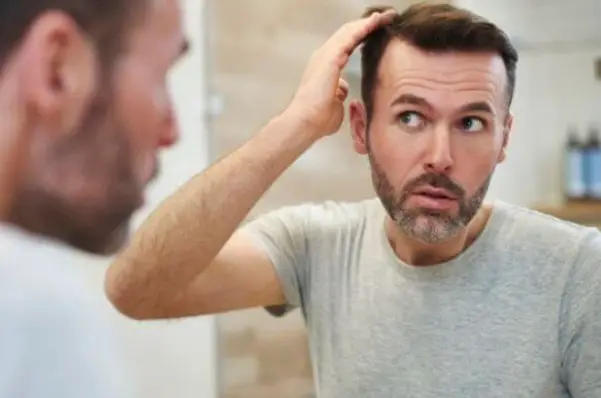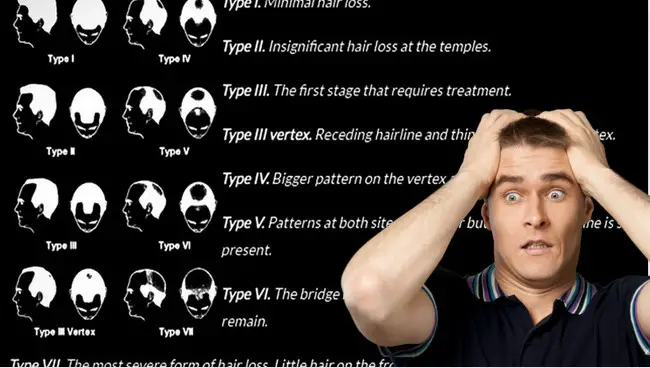Hair loss is a common concern for many people, and understanding the stages of hair loss can be crucial in tackling the issue effectively. One of the most widely used scales to measure the progression of male pattern baldness is the Norwood Scale. This scale is a key tool in understanding where you might stand in the hair loss journey. In this comprehensive guide, we will delve into the initial stage of the Norwood Scale, known as Norwood 0.
Understanding Norwood 0 is important as it represents the stage where no significant hair loss or recession of the hairline has occurred. It’s the stage where your hair is at its fullest, and understanding this stage can help you maintain your hair health and take preventive measures if necessary.
In this blog post, we will explore what Norwood 0 is, how it differs from other stages, the causes of hair loss at this stage, and the available treatment options. We will also address some frequently asked questions about Norwood 0. So, whether you’re at Norwood 0, worried about hair loss, or just curious, this guide is for you.
Let’s start our journey by understanding what Norwood 0 is and how it fits into the broader context of the Norwood Scale. But before we dive in, you might find our article on Norwood Scale stages helpful for a broader understanding of the topic.
Stay tuned as we unravel the mysteries of Norwood 0 and help you navigate the path of hair health.
Takeaways from the Blog Post
In this comprehensive guide, we explored the concept of Norwood 0 on the Norwood Scale, a classification system for different stages of male pattern baldness. Here are the key takeaways:
- Understanding Norwood 0: Norwood 0 refers to a stage where there is no noticeable hair loss or recession of the hairline. It’s the stage most boys’ hair will remain at until their hairline matures, typically in the late teens and early 20s.
- Norwood 0 vs Other Stages: Unlike other stages on the Norwood Scale, Norwood 0 indicates no significant hair loss or recession of the hairline. As you progress through the stages, hair loss becomes more noticeable, particularly at the temples and the crown of the head.
- Causes of Hair Loss: At Norwood 0, there is typically no hair loss. However, factors such as genetics, hormonal changes, stress, and poor nutrition can contribute to hair loss as you progress through the Norwood Scale stages.
- Treatment Options: For Norwood 0, no treatment is necessary as there is no significant hair loss. However, if you start experiencing hair loss, treatments such as minoxidil, finasteride, and hair transplant surgery can be considered. It’s always best to consult with a professional hair loss specialist for an official diagnosis and treatment plan.
- Prevention: While you can’t change your genetics, maintaining a healthy lifestyle can help slow down hair loss. This includes a balanced diet, regular exercise, stress management, and avoiding damaging hair practices.
Remember, hair loss is a common condition that many people experience. With the right knowledge and resources, you can manage it effectively and maintain your confidence.
What is Norwood 0?
Norwood 0 is the stage of the Norwood Scale (Classifications of Patterned Hair Loss) where no significant hair loss or recession of the hairline has occurred. It’s the stage where your hair is at its fullest, with no visible signs of thinning or balding. If you’re at Norwood 0, you should consider yourself fortunate as you’re at the stage where your hair is at its healthiest.
But what does it mean to be at Norwood 0? Let’s break it down:
- Full Hairline: At Norwood 0, you have a full hairline with no signs of a receding hairline. This means that the hairline across your forehead and temples is intact, with no noticeable thinning or bald spots.
- No Visible Hair Loss: There’s no visible hair loss at the crown (the top of your head) or any other part of your scalp. Your hair density is consistent throughout your scalp, giving your hair a full and healthy appearance.
- Healthy Hair Growth: Your hair growth cycle is functioning normally, with healthy hair growth and normal shedding. You’re not experiencing excessive hair fall, and your hair strands are strong and healthy.
Understanding Norwood 0 is not just about knowing what it looks like, but also about understanding how it differs from Norwood 1 and other stages of the Norwood Scale. This understanding can help you monitor your hair health and take preventive measures if you notice any changes.
To get a better understanding of how Norwood 0 differs from other stages, you might find our article on Norwood 1 Balding helpful. It provides a detailed comparison between Norwood 0 and Norwood 1, helping you understand the subtle changes that occur as you move from one stage to the next.
In the next section, we will delve deeper into the differences between Norwood 0 and other stages of the Norwood Scale. Stay tuned as we unravel the intricacies of the Norwood Scale and help you understand your hair health better.
Norwood 0 vs. Other Stages
Understanding Norwood 0 becomes even more meaningful when we compare it with other stages of the Norwood Scale. Each stage of the scale represents a different level of hair loss, and knowing these differences can help you monitor your hair health effectively.
Let’s compare Norwood 0 with other stages:
Norwood 0 vs. Norwood 1
- Norwood 0: As we’ve discussed, at this stage, there’s no significant hair loss. The hairline is full, and there’s no visible thinning or balding.
- Norwood 1: This is the stage where minor recession at the temples begins. However, it’s often so slight that it’s still considered within the range of a mature hairline. The hair at the crown is still full with no noticeable thinning.
Understanding the difference between these two stages can help you detect early signs of hair loss. If you’re interested in learning more about Norwood 1, check out our detailed guide on Is Norwood 1 Balding?
Norwood 0 vs. Norwood 2
- Norwood 0: Again, at this stage, there’s no significant hair loss. The hairline is full, and there’s no visible thinning or balding.
- Norwood 2: This stage is characterized by a more noticeable recession at the temples, forming an “M” shaped hairline. However, there’s still no significant thinning at the crown.
Understanding the transition from Norwood 0 to Norwood 2 can help you take early action to prevent further hair loss. For more information on Norwood 2, you might find our article on Is Norwood 2 Balding? helpful.
Norwood 0 vs. Norwood 3
- Norwood 0: As we’ve discussed, at this stage, there’s no significant hair loss. The hairline is full, and there’s no visible thinning or balding.
- Norwood 3: This is the stage where the recession at the temples becomes deep enough to be considered baldness. There might also be noticeable thinning at the crown.
The transition from Norwood 0 to Norwood 3 represents a significant progression in hair loss. For a detailed understanding of Norwood 3, check out our comprehensive guide on Norwood 3.
By understanding these differences, you can monitor your hair health and take preventive measures if you notice any changes. In the next section, we will delve into the causes of hair loss at Norwood 0. Stay tuned as we continue our journey through the world of hair health.
Causes of Hair Loss at Norwood 0
At Norwood 0, you’re at the stage where your hair is at its healthiest, with no visible signs of hair loss. However, that doesn’t mean you’re immune to hair loss. Understanding the potential causes of hair loss even at this stage can help you maintain your hair health and take preventive measures if necessary.
Here are some potential causes of hair loss that can affect individuals even at Norwood 0:
- Genetics: Genetic predisposition is one of the most common causes of hair loss. If you have a family history of baldness, you might be more likely to experience hair loss at some point in your life.
- Hormonal Changes: Hormonal imbalances, such as those caused by thyroid issues or changes in testosterone levels, can lead to hair loss.
- Stress: High levels of stress can lead to a type of hair loss called telogen effluvium, where hair follicles are pushed into the resting phase, leading to increased hair shedding.
- Nutritional Deficiencies: Lack of essential nutrients like iron, vitamin D, and protein can affect hair health and lead to hair loss.
- Medical Conditions: Certain medical conditions, such as alopecia areata or scalp infections, can cause hair loss.
- Medications: Some medications, such as those used for cancer treatment or for certain mental health conditions, can cause hair loss as a side effect.
It’s important to note that everyone is unique, and what causes hair loss in one person might not be the same for another. If you’re at Norwood 0 and notice any changes in your hair health, it’s important to consult with a healthcare professional or a trichologist. They can help identify the cause of your hair loss and suggest appropriate treatment options.
If you’re interested in learning more about the causes of hair loss and how they can affect different stages of the Norwood Scale, check out our detailed guide on Male Pattern Baldness Stages.
In the next section, we will explore the treatment options available for Norwood 0. Stay tuned as we continue to guide you through the world of hair health.
Treatment Options for Norwood 0
At Norwood 0, your hair is at its healthiest, and you might not be experiencing any significant hair loss. However, that doesn’t mean you can’t take steps to maintain your hair health and prevent potential hair loss. There are several treatment options available that can help you maintain your hair health at Norwood 0.
Here are some treatment options you might consider:
| Treatment Type | Description | Example |
|---|---|---|
| Medications | Used in early stages of hair loss to slow down or stop further hair loss | Minoxidil, Finasteride |
| Surgical Options | Used in later stages of hair loss to restore fuller appearance | Hair Transplant Surgery |
| Non-Surgical Options | Used to stimulate hair growth and maintain hair health | Medicated Shampoos, Lotions |
- Healthy Diet and Lifestyle: Maintaining a balanced diet rich in essential nutrients can help support hair health. Regular exercise, adequate sleep, and stress management can also contribute to overall hair health.
- Hair Care Routine: A good hair care routine, including regular shampooing and conditioning, can help maintain hair health. Avoid harsh treatments such as chemical dyes and heat styling that can damage hair.
- Scalp Massage: Regular scalp massages can help stimulate blood flow to the scalp, promoting hair health.
- Hair Growth Supplements: Certain supplements, such as biotin or other vitamins and minerals, can support hair health. However, it’s important to consult with a healthcare professional before starting any new supplement regimen.
- Medications: While not typically necessary at Norwood 0, medications like minoxidil or finasteride can be used to prevent hair loss in individuals with a high risk of balding. These medications should only be used under the guidance of a healthcare professional.
- Hair Transplant: While not typically considered at Norwood 0, hair transplant procedures can be an option for individuals experiencing hair loss. However, these procedures should only be considered after thorough consultation with a hair loss specialist.
Remember, prevention is better than cure. Taking steps to maintain your hair health at Norwood 0 can help prevent future hair loss. If you’re interested in exploring treatment options for hair loss, check out our comprehensive guide on Stages of Balding Treatment.
In the next section, we will address some frequently asked questions about Norwood 0. Stay tuned as we continue to guide you through the world of hair health.
Frequently Asked Questions about Norwood 0
In this section, we’ll address some of the most common questions about Norwood 0. This will help you gain a deeper understanding of this stage and what it means for your hair health.
-
What is Norwood 0?
Norwood 0, also known as a juvenile hairline, refers to a stage where there is no noticeable hair loss or recession of the hairline. It’s the stage most boys’ hair will remain at until their hairline matures, typically in the late teens and early 20s.
-
How is Norwood 0 different from other stages on the Norwood Scale?
Unlike other stages on the Norwood Scale, Norwood 0 indicates no significant hair loss or recession of the hairline. As you progress through the stages, hair loss becomes more noticeable, particularly at the temples and the crown of the head.
-
What causes hair loss at Norwood 0?
At Norwood 0, there is typically no hair loss. However, factors such as genetics, hormonal changes, stress, and poor nutrition can contribute to hair loss as you progress through the Norwood Scale stages.
-
What are the treatment options for Norwood 0?
For Norwood 0, no treatment is necessary as there is no significant hair loss. However, if you start experiencing hair loss, treatments such as minoxidil, finasteride, and hair transplant surgery can be considered. It’s always best to consult with a professional hair loss specialist for an official diagnosis and treatment plan.
-
Can I prevent progression from Norwood 0?
While you can’t change your genetics, maintaining a healthy lifestyle can help slow down hair loss. This includes a balanced diet, regular exercise, stress management, and avoiding damaging hair practices. Regular check-ups with a hair loss specialist can also help monitor your hair health and catch any potential issues early.
Remember, if you have any concerns about your hair health, it’s always best to consult with a professional. For more information on hair loss stages and treatments, check out our articles on Norwood 3, Norwood 4, and Norwood 6.
Conclusion
Understanding the stages of hair loss is crucial in managing and treating it effectively. The Norwood Scale provides a comprehensive guide to the different stages of male pattern baldness, starting from Norwood 0, where there is no noticeable hair loss.
While Norwood 0 is the ideal stage where no hair loss is observed, it’s important to remember that hair loss is a natural process that many people experience. If you notice any changes in your hairline or hair thickness, don’t panic. There are numerous treatment options available, from medications like minoxidil and finasteride to surgical procedures like hair transplants.
Early detection and treatment can significantly slow down the progression of hair loss. So, if you’re concerned about your hair health, it’s always best to consult with a professional. They can provide a proper diagnosis and recommend a treatment plan tailored to your specific needs.
Remember, hair loss doesn’t define you. It’s a common condition that many people experience. With the right knowledge and resources, you can manage it effectively and maintain your confidence.
For more information on the stages of hair loss and the different treatment options available, check out our comprehensive guides on Norwood 3, Norwood 4, and Norwood 6. These articles provide in-depth information on each stage and the best ways to manage and treat hair loss at each stage.
Thank you for reading, and remember, you’re not alone in your hair loss journey. We’re here to provide the information and support you need to navigate it effectively.
Related Articles:
- AI Powered Bald Filter Online 2024: See Yourself with No Hair! - January 19, 2024
- Harklinikken Bad Reviews 2024: Analyzing Negative Feedbacks - January 18, 2024
- How to Get the Alex Eubank Hair | Step-By-Step Tutorial 2024 - January 18, 2024







